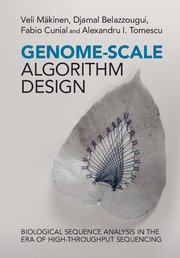7 - Hidden Markov models (HMMs)
from Part II - Fundamentals of Biological Sequence Analysis
Published online by Cambridge University Press: 05 May 2015
Summary
In the previous chapter we discussed how to analyze a sequence with respect to one or more other sequences, through various alignment techniques. In this chapter we introduce a different model, one that can abstract our biological insight about the available sequences, and can provide findings about a new sequence S. For example, given the simple assumption that in prokaryote genomes the coding regions have more C and G nucleotides than A and T nucleotides, we would like to find a segmentation of S into coding and non-coding regions. We will develop this toy problem in Example 7.1.
The model introduced by this chapter is called a hidden Markov model (HMM). Even though this is a probabilistic one, which thus copes with the often empirical nature of our biological understanding, we should stress that the focus of our presentation is mainly algorithmic. We will illustrate how simple techniques such as dynamic programming, and in particular the Bellman–Ford method from Section 4.2.2, can provide elegant solutions in this probabilistic context. The exercises given at the end of this chapter derive some other probabilistic models that connect back to the problem of aligning biological sequences from the previous chapter.
Let us start by recalling that a Markov chain is a random process generating a sequence S = s1s2…sn such that the probability of generating, or emitting, each si is fixed beforehand and depends only on the previously generated symbols s1 … si−1; we will denote this probability by ℙ(si | s1 …si−1). An important subclass of Markov chains consists in those of finite history, namely those in which the probability of generating any symbol si depends only on the last k previous symbols, for some constant k; that is, ℙ(si | s1 …si−1) = ℙ(si | si−k … si−1) (k is called the order of the Markov chain).
- Type
- Chapter
- Information
- Genome-Scale Algorithm DesignBiological Sequence Analysis in the Era of High-Throughput Sequencing, pp. 113 - 126Publisher: Cambridge University PressPrint publication year: 2015



